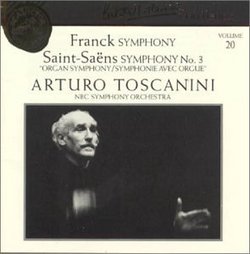| All Artists: Franck, Toscanini, NBC Title: Symphony in D Minor Members Wishing: 0 Total Copies: 0 Label: RCA Release Date: 3/10/1992 Genre: Classical Style: Symphonies Number of Discs: 1 SwapaCD Credits: 1 UPC: 090266032020 |
Search - Franck, Toscanini, NBC :: Symphony in D Minor
 | Franck, Toscanini, NBC Symphony in D Minor Genre: Classical
|
Larger Image |
CD DetailsSimilarly Requested CDs
|
CD ReviewsFresh Interpretations of Much-Maligned Masterworks! 09/16/1998 (5 out of 5 stars) "Toscanini was, as a conductor, akin to the restoration artists who work on old oil paintings, painstakingly removing layers of dull and crackled shellac, repairing rips and tears in the canvas, and replacing missing bits of paint that have been scraped away through careless handling and storage. A commonplace "repertoire piece" that one has heard innumerable times, and has become a bit tired and worn through over-familiarity, becomes exciting, new, and fresh again when viewed through the ever-young vitality of the Maestro's probing search for not only the precise details of the composer's intentions, but also the overarching architectural structure and "big picture" of a work. The Franck symphony is surely among the dullest of experiences in a typical routine matinee concert, under the baton of a maestro who has heard it much too often to take it seriously. But for Toscanini almost every concert was a life- and- death event of the deepest commitment. "PUT BLOOD!!" he screamed to his NBC Symphony players during rehearsals for his broadcasts and recordings. "YOU THINK I AM CRAZY? I am not crazy...SENSITIVE, YES!" he groaned during one specific encounter with an ensemble that did not seem to be giving him their all. It is not a crazy or obsessed man, but a sensitive one who conducts this composite recording of Franck's D Minor Symphony (the first movement comes from the broadcast of Dec. 14, 1940; the remaining two from March 24, 1946.) The sound is well matched, and the interpretation is diligent, powerful, emotional, and expressive, far surpassing (I think) the effort of Guido Cantelli with the NBC Symphony, recorded in stereo by RCA in 1954. To give his approval for release, the Maestro insisted on this particular intermingling of the two performances, despite the 6 year difference in their occurrence (and the superiority of the sound in the latter recording.) Music & Arts has issued an excellent transfer of the 1940 program on CD 898, and Dell'Arte has supplied the 1946 rendition on CD DA 9021. If you have neither of these, this authorized RCA/BMG CD will do nicely: it has the best possible "in-house" sound, and one will not be troubled by the difference in source dates.The Saint-Saens "Organ" Symphony has grown immeasurably in popularity, aided by the development of "hi fi" and home reproduction equipment; this listener remembers when there were only a couple of versions extant, the ancient Coppola shellacs c. 1930, and the post-war NYP account by Munch. Then came the hell- for- leather Boston Symphony/ Zamkochian/ Munch interpretation for RCA Red Seal, and the "over the top" approach to this powerhouse symphony seems to have been sealed in amber for all time. Most conductors play it as a raucous showpiece; Toscanini is much more reserved and "severe" in his Nov. 15, 1952 broadcast, somewhat marred by a very strange sounding organ (can it be an early electronic model? It almost wheezes, and sounds like an underpowered Wurlitzer.) But the cumulative effect of this very honest and rigorous approach is to make one suspect that Munch and his extroverted conducting cohorts are reading a bit too much into this piece, and failing to preserve the classical Gallic qualities that are inherent. Without a Monteux reading as an ultimate reference for style, I consider this Toscanini and the stereo version by Paray as benchmarks for the work.Rumor has it, unfortunately, that the RCA producer (and onetime Toscanini conducting student) Charles Gerhardt reprocessed the master tapes of this broadcast, adding peak limiting and midrange boost equalization, to "punch up" the sound and reduce the dynamics for more "effective" reproduction on LP records. One imagines from the rather strange quality of this broadcast that these selfsame "LP production" tapes -- rather than raw aircheck ones -- were employed for the preparation of this CD. I am told that amateur tapes, made off the air in the New York area at 15 ips on good machines, have preserved much more vital brilliance and impact in their copies than has the source used for this CD. I even preferred my old early "plum label" Victor Red Seal mono pressing to this CD release, though of course it had ticks, pops, and inner groove distortion not present on the compact disk. Finally, I resorted to dubbing this onto tape with my own choice of correcting equalization and audio expansion, and have recovered something of the vitality I recall from the LP. But I am a fanatic...if you are a normal, sane Toscanini collector, you are likely to be perfectly satisfied with this excellent reissue which -- at its worst in the Saint-Saens' finale -- is not too much inferior to the RCA/BMG issue of the live 1952 broadcast of Toscanini's Beethoven Fourth Symphony. Otherwise, I have found about 99% of the authorized RCA/BMG Toscanini Collection CDs to sound as good as, or better than, any previous LP or CD release.But please do not expect the organ registration to knock your socks off and trigger your subwoofer! Console yourself with the integrity and purity of the grave and eloquent Franck performance." Symphony with Organ 12/24/1998 (5 out of 5 stars) "This CD happens to be one of my favorite, even after reading the last reviewer's comments on its mastering. Yes, I do hope one day we will find those proverbial superior radio transcriptions, but for now these will do fine. I particularly love the performance of the Saint-Saens. People now seem to overlook the composer's own wordage in naming this piece. The direct translation is: Symphony with Organ. That does not mean Organ Concerto. It's a Symphony with an Organ, and that's how Toscanini took it. The organist just didn't have the super high stops in use, probably at the conductors wishes. In this recording the organ blends with the orechestra, doesn't stick out and provides the foundation without rocking the hall. Also, the last movement of this symphony is extraordinary because one can hear thebeautiful cascading piano accompaniment that occurs during the first statement of that beautiful theme. I know the organ sounds odd, but that can probably be attributed to the lack of using the best source material. And the Franck is simply astounding, especially in the last part of the first movement."
|

 Track Listings (7) - Disc #1
Track Listings (7) - Disc #1
